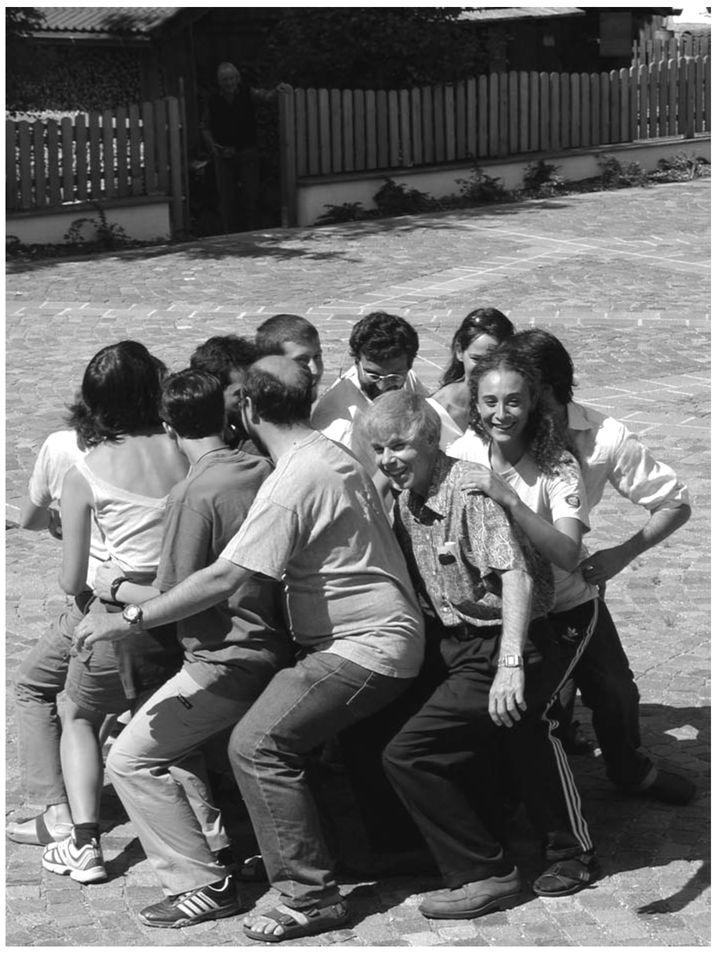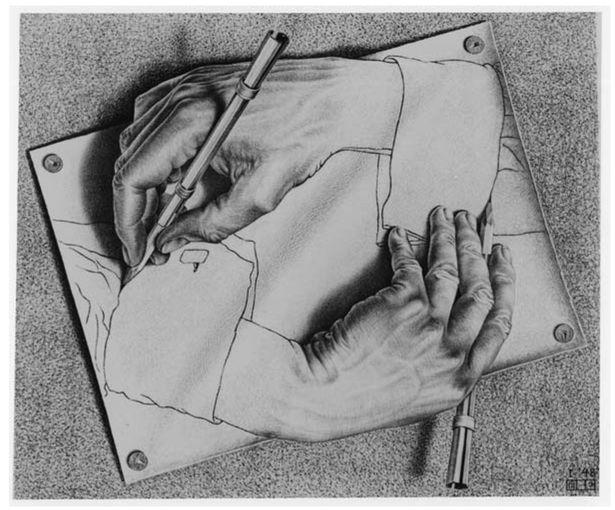I Am a Strange Loop (23 page)


CHAPTER 8
Embarking on a Strange-Loop Safari

Flap Loop, Lap Loop
I
’VE already described, in Chapter 4, how enchanted I was as a child by the brazen act of closing a cardboard box by folding down its four flaps in a cyclic order. It always gave me a
frisson
of delight (and even today it still does a little bit) to perform that final
verboten
fold, and thus to feel I was flirting dangerously with paradoxicality. Needless to say, however, actual paradox was never achieved.
A close cousin to this “flap loop” is the “lap loop”, shown on the facing page. There I am with a big grin (I’ll call myself “A”), front and center in Anterselva di Mezzo, sitting on the lap of a young woman (“B”), also grinning, with B sitting on C’s lap, C on D’s lap, and so forth, until one complete lap has been made, with person K sitting on
my
lap. One lap with lots of laps but no collapse. If you’ve never played this game, I suggest you try it. One feels rather baffled about what on earth is holding the loop up.
Like the flap loop, this lap loop grazes paradoxicality, since each of its eleven lap-leaps is an upwards leap, but obviously, since a lap loop can be realized in the physical world, it cannot constitute a genuine paradox. Even so, when I played the “A” role in this lap loop, I felt as if I was sitting, albeit indirectly, on my own lap! This was a most strange sensation.
Seeking Strange Loopiness in Escher
And yet when I say “strange loop”, I have something else in mind — a less concrete, more elusive notion. What I mean by “strange loop” is — here goes a first stab, anyway — not a physical circuit but an abstract loop in which, in the series of stages that constitute the cycling-around, there is a shift from one level of abstraction (or structure) to another, which feels like an upwards movement in a hierarchy, and yet somehow the successive “upward” shifts turn out to give rise to a closed cycle. That is, despite one’s sense of departing ever further from one’s origin, one winds up, to one’s shock, exactly where one had started out. In short, a strange loop is a paradoxical level-crossing feedback loop.

One of the most canonical (and, I am sorry to say, now hackneyed) examples is M. C. Escher’s lithograph
Drawing Hands
(above), in which (depending on where one starts) one sees a right hand drawing a picture of a left hand (nothing paradoxical yet), and yet the left hand turns out to be drawing the right hand (all at once, it’s a deep paradox).
Here, the abstract shift in levels would be the upward leap from
drawn
to
drawer
(or equally, from
image
to
artist
), the latter level being intuitively “above” the former, in more senses than one. To begin with, a drawer is always a sentient, mobile being, whereas a drawn is a frozen, immobile image (possibly of an inanimate object, possibly of an animate entity, but in any case motionless). Secondly, whereas a drawer is three-dimensional, a drawn is two-dimensional. And thirdly, a drawer
chooses
what to draw, whereas a drawn has no say in the matter. In at least these three senses, then, the leap from a drawn to a drawer always has an “upwards” feel to it.
As we’ve just stated, there is by definition a sharp, clear, upwards jump from any drawn image to its drawer — and yet in
Drawing Hands,
this rule of upwardness has been sharply and cleanly violated, for each of the hands is hierarchically “above” the other! How is that possible? Well, the answer is obvious: the whole thing is merely a drawn image, merely a fantasy. But because it looks so real, because it sucks us so effectively into its paradoxical world, it fools us, at least briefly, into believing in its reality. And moreover, we delight in being taken in by the hoax, hence the picture’s popularity.
The abstract structure in
Drawing Hands
would constitute a perfect example of a genuine strange loop, were it not for that one little defect — what we think we see is
not
genuine; it’s fake! To be sure, it’s so impeccably drawn that we
seem
to be perceiving a full-fledged, true-blue, card-carrying paradox — but this conviction arises in us only thanks to our having suspended our disbelief and mentally slipped into Escher’s seductive world. We fall, at least momentarily, for an illusion.
Seeking Strange Loops in Feedback
Is there, then, any
genuine
strange loop — a paradoxical structure that nonetheless undeniably belongs to the world we live in — or are so-called strange loops always just illusions that merely graze paradox, always just fantasies that merely flirt with paradox, always just bewitching bubbles that inevitably pop when approached too closely?
Well, what about our old friend video feedback as a candidate for strange loopiness? Unfortunately, although this modern phenomenon is very loopy and flirts with infinity, it has nothing in the least paradoxical to it — no more than does its simpler and older cousin, audio feedback. To be sure, if one points the TV camera straight at the screen (or brings the microphone right up to the loudspeaker) one gets that strange feeling of playing with fire, not only by violating a natural-seeming hierarchy but also by seeming to create a true infinite regress — but when one thinks about it, one realizes that there was no ironclad hierarchy to begin with, and the suggested infinity is never reached; then the bubble just pops. So although feedback loops of this sort are indisputably loops, and although they feel a bit strange, they are not members of the category “strange loop”.
Seeking Strange Loops in the Russellian Gloom
Fortunately, there do exist strange loops that are not illusions. I say “fortunately” because the thesis of this book is that we ourselves — not our bodies, but our
selves
— are strange loops, and so if all strange loops were illusions, then we would all be illusions, and that would be a great shame. So it’s fortunate that some strange loops exist in the real world.
On the other hand, it is not a piece of cake to exhibit one for all to see. Strange loops are shy creatures, and they tend to avoid the light of day. The quintessential example of this phenomenon, in fact, was only discovered in 1930 by Kurt Gödel, and he found it lurking in, of all places, the gloomy, austere, supposedly paradox-proof castle of Bertrand Russell’s theory of types.
What was a 24-year-old Austrian logician doing, snooping about in this harsh and forbidding British citadel? He was fascinated by paradoxes, and although he knew they had supposedly been driven out by Russell and Whitehead, he nonetheless intuited that there was something in the extremely rich and flexible nature of numbers that had a propensity to let paradox bloom even in the most arid-seeming of deserts or the most sterilized of granite palaces. Gödel’s suspicions had been aroused by a recent plethora of paradoxes dealing with numbers in curious new ways, and he felt convinced that there was something profound about these tricky games, even though some people claimed to have ways of defusing them.
Mr Berry of the Bodleian
One of these quirky paradoxes had been concocted by an Oxford librarian named G. G. Berry in 1904, two years before Gödel was born. Berry was intrigued by the subtle possibilities for describing numbers in words. He noticed that if you look hard enough, you can find a quite concise description of just about any integer you name. For instance, the integer 12 takes only one syllable to name, the integer 153 is pinpointable in but four syllables (“twelve squared plus nine” or “nine seventeens”), the integer 1,000,011 is nameable in just six syllables (“one million eleven”), and so forth. In how few syllables can you describe the number 1737?
In general, one would think that the larger the number, the longer any description of it would have to be, but it all depends on how easily the number is expressible in terms of “landmark” integers — those rare integers that have exceptionally short names or descriptions, such as ten to the trillion, with its extremely economic five-syllable description. Most large numbers, of course, are neither landmarks nor anywhere near one. Indeed, by far most numbers are “obscure”, admitting only of very long and complex descriptions because, well, they are just “hard to describe”, like remote outposts located way out in the boondocks, and which one can reach only by taking a long series of tiny side roads that get ever narrower and bumpier as one draws nearer to the destination.
Consider 777,777, whose standard English name, “seven hundred seventy-seven thousand seven hundred seventy-seven”, is pretty long — 20 syllables, in fact. But this number has a somewhat shorter description: “777 times 1001” (“seven hundred seventy-seven times one thousand and one”), which is just 15 syllables long. Quite a savings! And we can compress it yet further: “three to the sixth plus forty-eight, all times ten cubed plus one” or even the stark “the number whose numeral is six sevens in a row”. Either way, we’re down to 14 syllables.
Working hard, we could come up with scads of English-language expressions that designate the value 777,777, and some of them, when spoken aloud, might contain very few syllables. How about “7007 times 111” (“seven thousand seven times one hundred eleven”), for instance? Down to 13 syllables! And how about “nine cubed plus forty-eight, all times ten cubed plus one”? Down to 12! And what about “thrice thirty-nine times seven thousand seven”? Down to just 11! Just how far down can we squeeze our descriptions of this number? It’s not in the least obvious, because 777,777 just
might
have some subtle arithmetical property allowing it to be very concisely expressed. Such a description might even involve references to landmark numbers much larger than 777,777 itself!
Librarian Berry, after ruminating about the subtle nature of the search for ever shorter descriptions, came up with a devilish characterization of a very special number, which I’ll dub
b
in his honor:
b
is the smallest integer whose English-language descriptions always use at least thirty syllables. In other words,
b
has no precise characterization shorter than thirty syllables. Since it always takes such a large number of syllables to describe it, we know that
b
must be a huge integer. Just how big, roughly, would
b
be?
Any large number that you run into in a newspaper or magazine or an astronomy or physics text is almost surely describable in a dozen syllables, twenty at most. For instance, Avogadro’s number (6×10
23
) can be specified in a very compact fashion (“six times ten to the twenty-third” — a mere eight syllables). You will not have an easy time finding a number so huge that no matter how you describe it, at least thirty syllables are involved.
In any case, Berry’s
b
is, by definition, the very
first
integer that can’t be boiled down to below thirty syllables of our fair tongue. It is, I repeat, using italics for emphasis,
the smallest integer whose English-language descriptions always use at least thirty syllables.
But wait a moment! How many syllables does my italicized phrase contain? Count them — 24. We somehow described
b
in fewer syllables than its definition allows. In fact, the italicized phrase does not merely describe
b
“somehow”; it is
b
’s very
definition
! So the concept of
b
is nastily self-undermining. Something very strange is going on.
